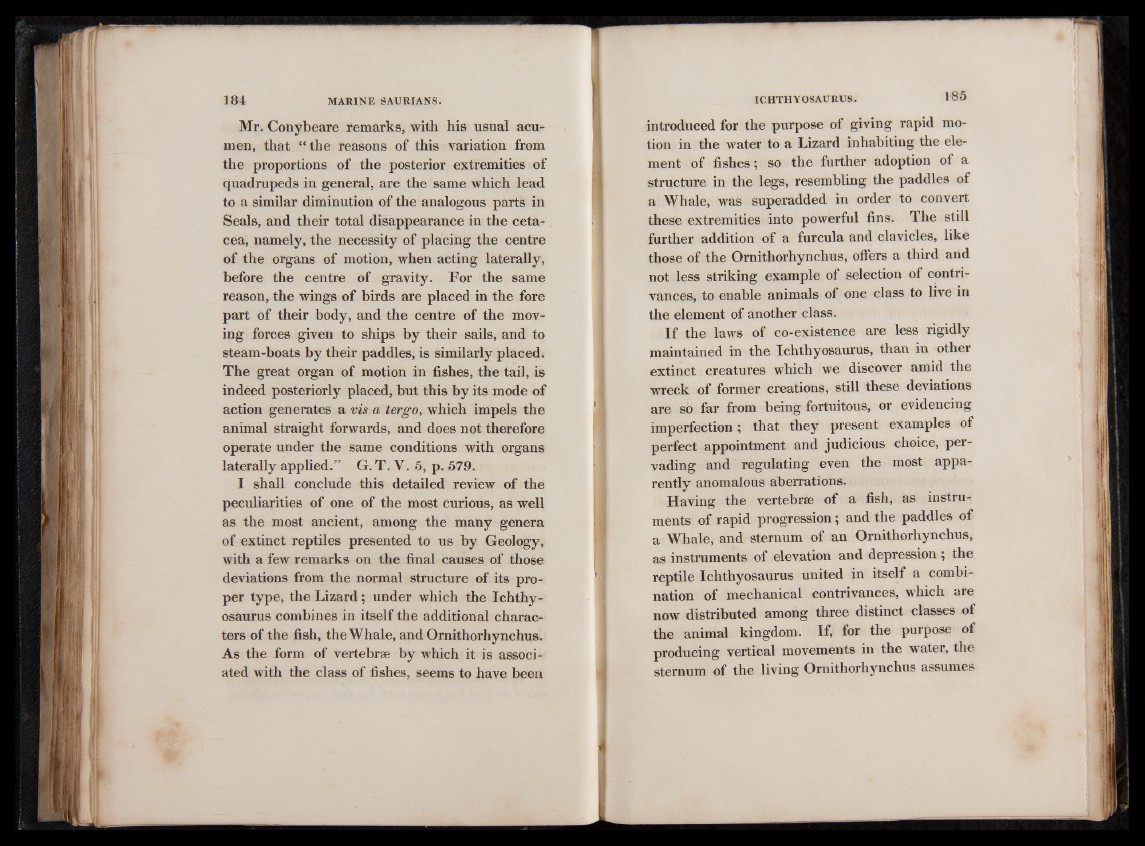
Mr. Conybeare remarks, with his usual acumen,
that “ the reasons of this variation from
the proportions of the posterior extremities of
quadrupeds in general, are the same which lead
to a similar diminution of the analogous parts in
Seals, and their total disappearance in the cetacea,
namely, the necessity of placing the centre
of the organs of motion, when acting laterally,
before the centre of gravity. For the same
reason, the wings of birds are placed in the fore
part of their body, and the centre of the moving
forces given to ships by their sails, and to
steam-boats by their paddles, is similarly placed.
The great organ of motion in fishes, the tail, is
indeed posteriorly placed, but this by its mode of
action generates a vis a tergo, which impels the
animal straight forwards, and does not therefore
operate under the same conditions with organs
laterally applied.” G. T. V. 5, p. 579.
I shall conclude this detailed review of the
peculiarities of one of the most curious, as well
as the most ancient, among the many genera
of extinct reptiles presented to us by Geology,
with a few remarks on the final causes of those
deviations from the normal structure of its proper
type, the Lizard; under which the Ichthyosaurus
combines in itself the additional characters
of the fish, the Whale, and Ornithorhynchus.
As the form of vertebrae by which it is associated
with the class of fishes, seems to have been
introduced for the purpose of giving rapid motion
in the water to a Lizard inhabiting the element
of fishes; so the further adoption of a
structure in the legs, resembling the paddles of
a Whale, was superadded in order to convert
these extremities into powerful fins. The still
further addition of a furcula and clavicles, like
those of the Ornithorhynchus, offers a third and
not less striking example of selection of contrivances,
to enable animals of one class to live in
the element of another class.
I f the laws of co-existence are less rigidly
maintained in the Ichthyosaurus, than in other
extinct creatures which we discover amid the
wreck of former creations, still these deviations
are so far from being fortuitous, or evidencing
imperfection; that they present examples of
perfect appointment and judicious choice, pervading
and regulating even the most apparently
anomalous aberrations.
Having the vertebrae of a fish, as instruments
of rapid progression; and the paddles of
a Whale, and sternum of an Ornithorhynchus,
as instruments of elevation and depression ; the
reptile Ichthyosaurus united in itself a combination
of mechanical contrivances, which are
now distributed among three distinct classes of
the animal kingdom. If, for the purpose of
producing vertical movements in the water, the
sternum of the living Ornithorhynchus assumes